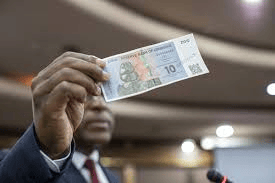The Reserve Bank of Zimbabwe has decided to keep its Monetary Policy Rate at 35% despite the continued depreciation of the country’s newly introduced currency, Zimbabwe Gold (ZiG). This move signals the central bank’s commitment to maintaining a tight monetary policy stance throughout 2025 in an effort to curb inflation and stabilize the currency. However, ZiG, which was launched in April 2024 as Zimbabwe’s sixth attempt at a stable currency, has already lost more than 43% of its value, raising concerns about its long-term viability.
In September 2024, the Reserve Bank of Zimbabwe took drastic measures to address the currency’s instability by devaluing ZiG from 13.9 per U.S. dollar to 24.3 per dollar while also increasing interest rates by 15 percentage points to the current 35%. The move was aimed at controlling inflation and discouraging excessive borrowing, but it has done little to prevent ZiG’s continued decline. According to the latest figures from the central bank, ZiG was trading at 24.6 per dollar as of Thursday when the monetary policy decision was announced.
One of the biggest challenges facing ZiG is its poor adoption by Zimbabwean residents. Currently, only about 30% of the population uses the currency for transactions, while the majority continues to rely on the U.S. dollar for everyday purchases. This widespread preference for the dollar further weakens ZiG’s credibility, making it difficult for the central bank’s policies to have the desired effect. The lack of confidence in the new currency has created a challenging environment for monetary authorities, who are struggling to encourage broader adoption while keeping inflation under control.
Reserve Bank Governor John Mushayavanhu defended the decision to maintain the high benchmark interest rate, stating that it is necessary to curb market volatility. However, despite these efforts, inflation has been rising sharply in both ZiG and U.S. dollar terms. In January, inflation in ZiG terms surged from 3.7% to 10.5% month-on-month, while inflation in dollar terms jumped from 2.5% to 14.6% over the same period. The primary drivers of this inflationary trend have been escalating food prices and higher housing costs, further straining household budgets.
On a more positive note, the governor highlighted that Zimbabwe’s foreign currency reserves increased to $548 million in January. This rise in reserves could provide some cushion for the central bank’s monetary policies, though it is unclear whether it will be enough to restore confidence in the local currency. Still, the growing reserves may offer the government more flexibility in managing the country’s economic challenges.
Despite the Reserve Bank’s firm stance on maintaining high interest rates, there is growing tension between the central bank and key financial market players. Stock investors and lenders have called for a more accommodative monetary policy, arguing that the current high rates are restricting economic activity and discouraging investment. However, the central bank remains focused on preventing further devaluation of ZiG and controlling inflation, even at the risk of slowing down business growth.
To complement its monetary policy efforts, the Reserve Bank introduced the Targeted Finance Facility late last year. This special-purpose vehicle is designed to provide funding for productive sectors of the economy, with the aim of stimulating growth while keeping inflation in check. The initiative is part of the broader strategy to stabilize the economy by supporting industries that can generate employment and foreign exchange earnings.
As Zimbabwe navigates these economic challenges, the success of ZiG will depend on the central bank’s ability to build public confidence in the currency while managing inflation and ensuring sufficient foreign reserves. The government faces the difficult task of balancing tight monetary policies with the need to encourage economic expansion. If the current policies fail to stabilize ZiG, Zimbabwe may once again find itself in a cycle of currency instability that has plagued the country for years.









